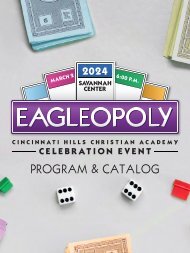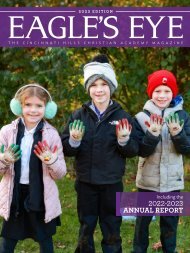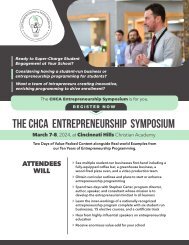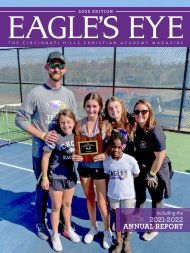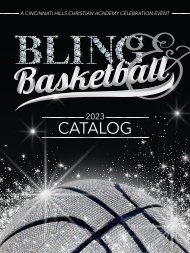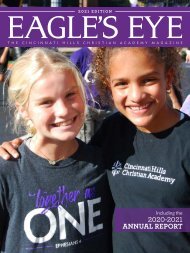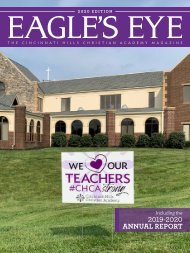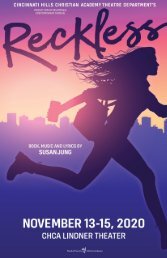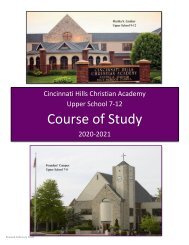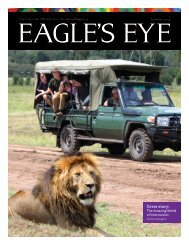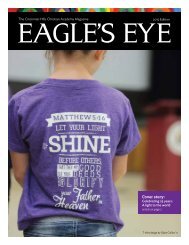Mission, Vision, Competencies, Standards, and Benchmarks
A Statement of Curriculum CINCINNATI HILLS CHRISTIAN ACADEMY Edyth B. Lindner Campus Otto Armleder Memorial Education Center Founders’ Campus Martha S. Lindner Campus 2019 Edition
A Statement of Curriculum
CINCINNATI HILLS CHRISTIAN ACADEMY
Edyth B. Lindner Campus
Otto Armleder Memorial Education Center
Founders’ Campus
Martha S. Lindner Campus
2019 Edition
Create successful ePaper yourself
Turn your PDF publications into a flip-book with our unique Google optimized e-Paper software.
‣ Perform with expression <strong>and</strong> technical accuracy a repertoire of instrumental literature that<br />
includes modest technicality <strong>and</strong> ranges, changes of tempo, key, <strong>and</strong> meter.<br />
‣ Study music that is congruent with a Christian worldview.<br />
‣ Apply or recognize the basics of music theory.<br />
‣ Read <strong>and</strong> notate whole, half, quarter, eight, sixteenth, <strong>and</strong> dotted notes, <strong>and</strong> their<br />
equivalent rests in 2/4, 3/4, 4/4, <strong>and</strong> 2/2 time signatures.<br />
‣ Recognize <strong>and</strong> incorporate into performances st<strong>and</strong>ard notation symbols for pitch,<br />
rhythm, dynamics, tempo, articulation, <strong>and</strong> expression.<br />
‣ Explain, using appropriate terminology, music notation, instruments, <strong>and</strong> performances.<br />
‣ Exercise evaluative criteria that affect quality <strong>and</strong> effectiveness of musical performances<br />
<strong>and</strong> compositions.<br />
‣ Exercise appropriate audience <strong>and</strong> performance etiquette.<br />
‣ Discern quality repertoire based on a Christian worldview.<br />
‣ Study instrumental music of various historical periods <strong>and</strong> cultures.<br />
‣ Underst<strong>and</strong> roles of musicians in various music settings <strong>and</strong> cultures.<br />
‣ Underst<strong>and</strong> diverse roles of music <strong>and</strong> musicians in various world cultures.<br />
By close of grade 12, Upper School students will:<br />
Vocal Music:<br />
‣ Sing a varied repertoire of Christian <strong>and</strong> appropriate vocal literature at a moderate level of<br />
difficulty with expression <strong>and</strong> technical accuracy.<br />
‣ Sing music written in two or four parts without accompaniment.<br />
‣ Use ensemble skills when performing as part of a group.<br />
‣ Use elements of music for expressive effect.<br />
‣ Read a vocal score up to four staves.<br />
‣ Read music that contains moderate technical dem<strong>and</strong>s, exp<strong>and</strong>ed ranges, <strong>and</strong> varied<br />
interpretive requirements.<br />
‣ Apply the technical vocabulary of music appropriate to student’s years of study.<br />
‣ Recognize compositional devices <strong>and</strong> techniques that are used to provide unity <strong>and</strong><br />
variety, tension <strong>and</strong> release in a work.<br />
‣ Research <strong>and</strong> describe various roles that musicians perform <strong>and</strong> representative<br />
individuals who have functioned in these roles.<br />
‣ Create <strong>and</strong> apply choreographic movement to song (performing choir only).<br />
Instrumental Music:<br />
‣ Perform with expression <strong>and</strong> technical accuracy a varied repertoire of musical literature<br />
including sacred selections at an intermediate to advanced level of difficulty.<br />
‣ Demonstrate ensemble skills when performing as part of a group.<br />
‣ Perform alone <strong>and</strong> in small ensembles with confidence <strong>and</strong> proficiency.<br />
‣ Improvise rhythmic <strong>and</strong> melodic phrases, incorporating variations <strong>and</strong> embellishments.<br />
‣ Improvise original melodies over given chord progressions in consistent style, meter<br />
<strong>and</strong> tonality.<br />
‣ Know how the elements <strong>and</strong> compositional devices of music achieve unity <strong>and</strong> variety,<br />
tension <strong>and</strong> release, <strong>and</strong> balance in musical compositions.<br />
‣ Read <strong>and</strong> notate music that contains intermediate to advanced technical dem<strong>and</strong>s,<br />
exp<strong>and</strong>ed ranges, <strong>and</strong> varied interpretive requirements.<br />
‣ Underst<strong>and</strong> how the elements of music <strong>and</strong> musical expression are used in diverse<br />
genres <strong>and</strong> cultures.<br />
‣ Apply the technical vocabulary of music appropriate to the student’s years of study.<br />
Back to Table of Contents




